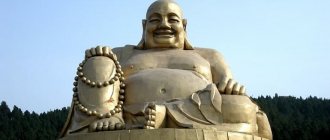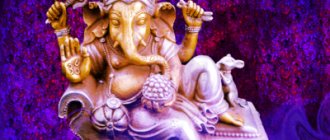Ganesha is an elephant-headed Hindu God. As a talisman, it brings wealth, luck, health, and blocks negative energy. On the desk in the office it promotes a career, but at home you need to be careful, as improper use of the amulet leads to unpleasant consequences. The famous idol is known not only in India, but also far beyond its borders.
Description of the talisman
Ganesha - depicted with a human body and the head of an elephant, he is an assistant in acquiring abundance and knowledge, success and well-being, as well as in business and happiness, he also helps. Ganesha’s big “belly” is a symbol of wealth and prosperity, and the ability to “digest” all sorts of troubles, and also, symbolically, of course, Ganesha, as if “swallows” and neutralizes troubles and misfortunes, protects us in this fragile world. Two tusks (one broken, the other whole) symbolize imperfection and, at the same time, perfection of our real world.
LiveInternetLiveInternet
Quote from Aishwarya_Roshan
Read in full In your quotation book or community!
Ganesha
Ganesha
The purpose of the talisman
Ganesh
is considered the god of wisdom and the remover of obstacles, is a patron and a powerful symbol of good luck in business. It is good to have a talisman on your desktop, at home or in the office. Ganesha will help you earn more, stimulate professional success and increase profits. It is better to place it in the zone of assistants - in the northwest.
The talisman is stone Ganesha made of semi-precious stones, copper, wood (for example, sandalwood), etc. In India, where Ganesha is especially revered, there are many plastic figurines. It doesn’t matter what material Ganesha is made of, only respectful attitude towards him is important. Activation of the talisman
For the talisman to work actively, you need to scratch Ganesha’s tummy or right palm.
In addition, can you put coins or candy next to it? Ganesha loves offerings and will definitely please you with pleasant surprises. One more nuance: this talisman can be activated with Hindu mantras: 1. OM GAM GANAPATAYA NAMAH. It is considered the most important mantra for the god Ganesha. She bestows purity of intentions, good luck in business and removes obstacles from the path. 2. OM SRI GANESHAYA NAMAH. As a result of repeating this mantra, success is achieved in any commercial endeavor, the desire for excellence, deep knowledge of the world, and the flowering of talents are realized. Legend says
The origin story and appearance of Ganesha are explained by several myths.
Some say that Parvati dreamed of a son, but Shiva did not give her this happiness. Then, by the power of her desire, she separated the tiny child from her skin and began to lovingly feed him with her milk. Other myths claim that Parvati molded a child from clay and brought him to life with the heat of her mother's love. There is also an option according to which Shiva, feeling sorry for his beloved, squeezed the edge of her light clothes into a ball and called him son. And the child came to life from the warmth of her breast. Parvati, proud of the beauty of the child, asked everyone to admire him and with the same request turned to the cruel god Shani, who could destroy everything he laid his eyes on. The foolish mother insisted that Shani look at the boy, and immediately the child's head disappeared. Brahma advised Parvati to give him the head of the first creature she came across. This creature turned out to be an elephant. According to another myth, Shiva himself, in anger, cut off the head of his son when he did not let him into Parvati’s chambers while she was taking a bath. Then, touched by the grief of his wife, Shiva ordered his servants to cut off the head of the first living creature they met on the way and bring this head. Having met the baby elephant, the servants cut off his head and delivered it to their master, who, by the power of divine spells, fixed this head on the child’s shoulders. Because of his heavy elephant head, Ganesha could not grow tall and slender, but his short, wide body had a kind heart, and everyone loved him. He grew up smart and calm, and when he matured, Shiva elevated him to the rank of ruler of all the demigods and spirits subordinate to him. Ganesha, with the help of the goddess Saraswati, comprehended many sciences, and therefore always favors people who strive for knowledge. According to legend, Ganesha lost one of his tusks in a collision with Parashurama, that is, the human incarnation of the god Vishnu. Parashurama came to visit Shiva, he was sleeping, and Ganesha refused to wake him. Parashurama could not contain his anger when he saw that this strange young man was obstructing him, and with one swing of his ax he cut off his tusk. No one dared to violate the will of Parashurama and correct what he had done, so Ganesha was forever left with one tusk. The story of the Feng Shui master
Ganesh (Sanskrit - “leader of a group”) is a late in time of formation (no earlier than the middle of the first millennium AD), but an extremely popular character in Hindu mythology of the Shaivite circle, the god of wisdom and the removal of obstacles.
Ganesha is very often depicted with a book and pen. According to mythology, he was a great scribe who wrote the Mahabharata. His image, in the form of a fat child with the head of an elephant and one broken tusk, is found in every Hindu temple. He has four arms (sometimes six, eight, and maybe even sixteen), occasionally ? three eyes. The belly is girded with a snake. Ganesha holds a lotus flower and a trident in his two upper hands. Behind Ganesha's head? round halo. Images of Ganesha are found in temples and homes. People who worship him believe that he will remove all obstacles in their path, wherever they meet? on the road and at sea, while traveling, in the study of sciences or crafts, in music and dancing. Therefore, many educational institutions place an image of Ganesha, as well as in stores, where they expect him to provide support in trade matters. (C) Ganesha and his 32 forms
images.google.com/imgres?imgurl=http%3A//pics .livejournal.com/latika/pic/… 1. Bala Ganapati - Beloved Child This child with the head of an elephant and four arms, has skin the color of the rays of the rising sun.
He holds banana, mango, jackfruit (East Indian breadfruit) and sugarcane in his hands, along with his favorite modak sweets in his trunk. Symbolizes wealth and fertility. 2. Taruna Ganapati - Young Ganesha Eight-armed Taruna Ganapati, “young” or “youthful”, holds in his hands a noose, a goad, modak sweets, wood-apple, syzygium (clove tree, “rose apple”) ), his broken tusk, a shoot of paddy, and a stalk of sugar cane. Its bright red color symbolizes the bloom of youth. 3. Bhakti Ganapati Devotee He shines like the full moon during the harvest season. Decorated with a garland of flowers, Bhakti Ganapati is affectionate towards those who worship him. He is pleasant to behold, holding a banana, mango, coconut, and a bowl of payasa (milk sweets) in his hands. 4. Vira Ganapati - Brave Warrior Vira Ganapati is a Valiant Warrior, depicted in red and has a stern appearance, in his 16 hands he holds a variety of weapons that symbolize the power of the mind: a glass, a chakra (throwing disc) , javelin, bow, arrow, sword, shield, great hammer, mace, noose, pickaxe, battle axe, trident, snake and banner. 5. Shakti Ganapati (Shakti Ganapati) - The Mighty One is powerful, with one hand he hugs the Shakti sitting on his lap, painted green. He himself is orange-red, holds in his hands a garland of flowers, a noose, a goad, and bestows the blessing of abhaya mudra. This form of Ganapati is revered in Tantrism. 6. Dvija Ganapati - Twice-Born Twice-Born. He has four heads, like Brahma, and in his hands he holds a scroll, a rosary, a kamandalu (water vessel) and a danda (staff), and sometimes also a noose and a goad. Dvija Ganapati's body is the color of the moon, and he wears lightning-shaped bangles on his hands. 7. Siddhi Ganapati - God of achievements Yellow-gold Siddhi Ganapati - “Perfect”, is the deity of achievements and self-control. He holds a bouquet of flowers, a mango, sugar cane and an axe, and sweets made from sesame seeds in his trunk. 8. Uchhishta Ganapati - Tantric deity Lord of Blessed Gifts and Guardian of Culture. Uchhishta Ganapati is blue in color and has six arms. With one hand he supports his Shakti, in the rest he holds a veena, a pomegranate, a blue lotus flower, a rosary and a shoot of paddy 9. Vighna Ganapati - Lord of Obstacles “Lord of Obstacles”, he is golden in color and decorated with jewels. In his eight hands he holds a shell and a disk, a bow made of sugar cane and flower arrows, also an axe, a noose, a goad, and a bouquet of flowers. Sometimes Ganesha can also be depicted with his tusk, modak sweets and a garland. 10. Kshipra Ganapati - The fast-acting god He is beautiful and red like a hibiscus flower, holding in his hands his broken tusk, a noose, a goad, a twig of the kalpavriksha tree (the wish-granting tree), and a pot of jewels in his trunk. 11. Heramba Ganapati - Protector of the weak Five-faced, dark green or white Heramba Ganapati - Protector of the weak. He rides on a lion, with his two hands in the position of Abhaya (protection) and Varada (granting) mudra. In his remaining hands Ganapati holds a noose, rosary, tusk, garland, axe, large hammer, fruit and modak sweets. 12. Lakshmi Ganapati - The One Who Gives Success His two shaktis - Siddhi (success) and Buddhi (mind) - sit on either side of him and hold blue lotuses. With one hand he shows the sign of Varada (endowment) mudra, in the remaining hands he holds a noose, a goad, a green parrot, a pomegranate, a sword, a shoot of a Kalpavriksha tree (a wish-fulfilling tree), as well as a kamandalu (water vessel). In this form, Ganesha is of pure white light. 13. Maha Ganapati - The Great Great One, he is accompanied by one of his shaktis, who sits on his knee holding a lotus. This aspect of Ganapati is red in color, has three eyes and has a crescent moon in its crown. In his hands he holds his tusk, a pomegranate, a blue lily, a sugarcane bow, a lotus, a gada (mace), a noose, a chakra, a shoot of paddy and a pot of jewels. He is also a tantric form. 14. Vijaya Ganapati - Victorious Red, four-armed, riding on a rat, Vijaya Ganapati is the victorious giver of success. Its distinctive features are a broken tusk, a goad, a noose, and its favorite fruit, the fragrant golden mango. 15. Nritya Ganapati - Joyful dancer Nritya Ganapati - four-armed, golden in color, wears rings on his fingers, holds a tusk, a noose, a goad, and sometimes modak sweets in his hands. He dances under the Kalpavriksha tree, symbolizing vibrant activity and joy. 16. Urdhva Ganapati - Tantrik Urdhva Ganapati sits holding one of his shaktis on his left hip, it is green in color. He himself is golden in color, and in his six hands he holds a paddy shoot, a lotus, a sugarcane bow, an arrow, his tusk and a blue water lily. 17. Ekaakshara Ganapati - Lord of one syllable (Gam) - one support of Red color, dressed in red silk clothes, wearing a garland of red flowers with a crescent moon in the crown, he sits in padmasana on his mount (mushika). He has three eyes and short arms and legs, Ekaakshara Ganapati holds a pomegranate, a noose and a goad in his three hands, and with the fourth shows Varada mudra (giving). 18. Varada Ganapati - Giver of blessings Varada (or Vara) Ganapati is a giver of blessings, he has three eyes, he is red in color, and the crown on his head is decorated with a crescent moon. He holds in his hands a noose, a goad, a dish of honey, and in his trunk a pot of jewelry. In the tantric version, the deity is depicted with his shakti sitting on his knee. 19. Tryakshara Ganapati - Lord of three letters - AUM (OM) - three supports He is the lord of three letters (A-U-M), golden in color, with small panicles on huge hanging ears. In his hands he holds a tusk, a noose and a goad, and in his trunk there are modak sweets. 20. Kshipra-Prasada Ganapati - Promiser of speedy reward He is the one who promises speedy reward. Kshipra-Prasada Ganapati sits on a throne of Kush grass, in this form his huge belly is especially noticeable, and he symbolizes the manifested Universe. Ganesha holds in his hands a noose, a goad, a tusk, a lotus, a pomegranate and a branch of a wish-granting tree. 21. Haridra Ganapati - Golden Golden, dressed in bright yellow robes, he sits calmly on the royal throne. Haridra Ganapati holds modak sweets in his trunk, a noose to draw his devotees closer, and a goad to urge them forward. Sometimes he still holds his broken tusk. 22. Ekadanta Ganapati - One-fanged One-fanged Ganapati is distinguished by its blue color and huge belly. He holds an ax with which he cuts off the bonds of ignorance, rosary, lada (sweets), and his right tusk. 23. Srishti Ganapati - The Creator Seated astride his vahana (rat), Srishti Ganapati is the Lord of joyful Manifestation. This active deity is red in color, holding a noose, a goad, a mango fruit and a tusk - a symbol of self-sacrifice. 24. Uddanda Ganapati - Punisher of evil Uddanda Ganapati is a brave guardian of Dharma, the law of existence. In his ten hands he holds a pot of jewels, a blue lily, a sugar cane, a mace, a lotus flower, a shoot of paddy, a pomegranate, a noose, a garland and his tusk. In tantric murtis, Ganesha is depicted with a green shakti sitting on his knee, holding a lotus flower in her hands. 25. Rinamochana Ganapati (Runamochana Ganapati) - Liberator from bondage The deliverer of humanity from guilt and slavery, Rinamochana Ganapati has alabaster-white skin, dressed in red silks. He holds a noose and a goad, a tusk and his favorite fruit - a rose apple (syzygium). 26. Dhundhi Ganapati - The mature minded Dhundhi Ganapati is the one to be sought after. He is red in color and holds a rudraksha bead, a broken tusk, an ax and a ratnakumbha (pot of jewels) in his hands, symbolizing the treasures of awakening that he preserves for his ardent devotees. 27. Dwimukha Ganapati - Two-Faced Sometimes he is called Janus, after the example of the Roman deity, since he has two heads looking in different directions. In this form, Ganapati is blue-green in color, dressed in red robes, wearing a crown studded with precious stones. In four hands he holds a noose, a goad, a tusk and a pot of jewels. 28. Trimukha Ganapati - Three-faced Trimukha Ganapati - Three-faced God, he is red in color, sits in the center of a golden lotus. In his hands he holds a prayer rosary, a noose, a goad and a pot and nectar. With his right hand he shows abhaya mudra (protection), and with his left hand he shows varada mudra (giving, blessing). 29. Simha Ganapati - Riding a Lion He is white in color, rides a lion and shows a second lion in one of his hands, which symbolizes his strength and fearlessness. In his other hands he holds a twig of a wish-granting tree, a veena, a lotus, a bouquet of flowers and a pot of jewels. 30. Yoga Ganapati - The great yogi Yoga Ganapati is absorbed in reciting a mantra, his knees tied in a yogic pose. The color of this murti is the color of the morning sun, he is dressed in blue, and holds a rosary, a yoga stick, a noose and a sugarcane stalk in his hands. 31. Durga Ganapati - Savior Durga Ganapati v Irresistible, Conqueror of Darkness. He has a huge body the color of scarlet gold, in his right hands he holds a rosary, an arrow, a goad and a tusk, and in his left hands a noose, a flag, a bow and a rose apple (syzygium). His clothes are red. 32. Sankatahara Ganapati - Dispelling Sorrows He is depicted with red skin, a blue robe, seated on a red lotus. He is accompanied by a green shakti, who sits on his thigh, holding a blue flower in her hands. In his hands, Sankatahara Ganapati holds a noose, a goad, a bowl of payasa (milk sweets), and with his right hand he shows Varada mudra (giving). If the image of Ganesha is not tantric, he appears without his shakti... August 23 (date for 2009) Birthday of the God of wisdom and abundance Ganesha
with the body of a man and the head of an elephant, the remover of obstacles, the son of Shiva and his wife Parvati. Celebrated in the month of Bhadra (August-September). Ganesha is one of the most revered gods of the Hindu pantheon. Any undertaking is accompanied by a prayer to Ganesha: “Om Ganeshaya namah.” The festival of Ganesh Chaturthi symbolizes a Good Omen. On this day, they worship Ganesha, bring him fruits, milk, flowers and sweets, break coconuts in front of the image of God. In some parts of the country (e.g. Maharashtra, Tamil Nadu), new images of Ganesha are made from raw clay on this day. After prayers, offerings and a brief farewell ceremony, the old images are immersed in the water of rivers, lakes and other bodies of water.
Symbols and talismans
images.google.com/imgres?imgurl=http%3A//www.01j.ru/imgs/ganesh1.bmp&imgr…
Safety precautions for using the talisman
And here are the safety precautions for using this wonderful talisman of success - Ganesha: 1) Do not install a figurine or figurine of Ganesha in your home if it is chipped or cracked, otherwise this talisman will act in the opposite way, i.e. attract troubles. 2) Periodically clean the Ganesha figurine from dust and dirt so that nothing prevents this wonderful talisman from attracting success to you in all your affairs. 3) When stroking the Ganesha figurine on the trunk and asking yourself for success, do not use words with the particle “not”, and naturally, never wish failure on other people (even if they are your competitors). 4) When you wish for something, at the end of the phrase, be sure to say: “For my good and the good of everyone around me!” This will lead you to even greater success in business without harming anyone.
Where is the best place to place it?
If a Ganesha statue is placed at the main entrance of the house, it deflects negative incoming energy. Keeping statues in your home and office brings good luck. You should not keep the idol outside, at the back of the room, in front of the door or window, as this brings poverty. The purpose of the talisman is to be kept at home to attract prosperity and prevent unpleasant influences. It is considered inauspicious to keep multiple statues. Based on the guidelines of Vastu shastra, the traditional system of remodeling in Hindu architecture, the amulet is not placed in the south or southeast sectors where God will not give blessings. Recommended directions: west, north or northeast.
It is forbidden to store the figurine in the bathroom and laundry room, these are rooms with unfavorable energy created from wastewater. It is also not recommended to keep in the kitchen - an area where waste from leftover or spoiled food is disposed of. Under the stairs, the figurine looks like a forgotten toy; according to Feng Shui, the space under the stairs stagnates and is considered unfavorable. The only thing they store there is cleaning products. It is disrespectful to place on the floor, it is necessary to give the figurine a place of honor and respect at its height. A table or cabinet is ideal, the deity is exalted.
What are the talismans of Ganesha?
The Ganesha talisman is made from a variety of materials, it can be: glass or wood, metal or semi-precious stone, even plastic is not forbidden. But it is best to buy this talisman metal or jade. In principle, it doesn’t matter what the talisman is made of, the main thing is to treat it with care and respect it. Ganesha can have a variety of objects in his hands, and now let’s look at what they symbolize. A bowl of sweets means: well-being, prosperity, and pleasure in our life. Iron hook: the need to curb your passions and control yourself, your irrepressible desires. A lotus in the hands of Ganesha indicates the divine principle, purity of thoughts and the perfection of our world. The rosary symbolizes our aspirations to achieve life goals and the acquisition of spiritual knowledge. The ropes in the hands of Ganesha remind us that a person should strive for high goals in life and not be strongly attached to material things. The snake wrapped around Ganesha's waist symbolizes energy in all its forms, incarnations and manifestations. Very often, the deity is depicted riding on a mouse, which is capable of overcoming any, even very huge, obstacles in life. Well, if the mouse is next to Ganesha, i.e. at his feet, this means that the fulfillment of desires and wealth are in his power.
Meaning of Ganesha
The elephant-headed god is recognized as the patron of the business sector. It removes obstacles on the path to success, moves you up the career ladder and brings professional success. Ganesha also has other meanings:
- increase in wealth;
- accumulation of the required amount;
- protection from enemies;
- eliminating fears and phobias.
Ganapati helps people who are engaged in creativity, science and crafts. He resides in the energy center responsible for material well-being and the instinct of self-preservation. They express their love and respect to him before starting to do anything. The Ganesha figurine is the first to be brought into the new house.
The god figurine is made from various materials. It doesn't matter what it's made of, the main thing is to handle it correctly.
How to activate this talisman
Ganesha loves to be stroked on his trunk and, in gratitude for this, he attracts success to his owner and protects him from all sorts of storms and troubles. To enhance the effect, you can stroke his tummy and right palm. Ganesha also loves to be treated to various delicacies. Place offerings at his feet: various sweets, coins, dried fruits, pineapple pieces, banana or coconuts. If Ganesha is depicted with a mouse, then feed it too (corn, nuts, grain). Do not skimp on the treats and very soon you will receive pleasant surprises and gifts in the form of abundance and success in all matters. In any situation, for example, if you feel bad or are in trouble, you can take the Ganesha figurine in your hand and, stroking his trunk or palm, ask for help, telling about your problems and sorrows. Rest assured, your request will not go unheeded. The deity will definitely help you. This kind and wonderful talisman controls recognition in society, taming evil forces, helps to overcome any obstacles, creates harmony in your life and success in business, brings wisdom and skills, and gives a person peace. Ganesha also controls construction, literature, various types of luck, travel, in a word, many areas of life in which you want to succeed and in which knowledge and skills are required. When starting a new business, you can also turn to this good deity for help.
Where to put a figurine of the deity of success - Ganesha
You can place a Ganesha figurine in the northwestern zone of your apartment, house or office (the sector of assistants). This deity belongs in your office. Place the figurine on your desktop, but not directly in front of you, but slightly to the right. This talisman will stimulate your professional growth, increase your income and will help in various matters. And where there is success, there is glory, which means that in the south (fame sector) of your house or apartment, this talisman will not be superfluous, just try to make the Ganesha figurine look expensive and rich. And also, make sure that the figurine (for the glory zone) is made of wood (wood - feeds fire - in the circle of generation), preferably red (fire element). And of course, this talisman can also be placed in the career sector (northern zone of your home or office). This wonderful talisman will bring you prosperity and success in business. It is believed that the larger the Ganesha figurine, the more success and money it attracts. Yes, this is true, but even if the figurine is small, then make sure that it looks elegant, expensive, even luxurious. But, in any case, it’s up to you to decide what size your talisman will be, since small figurines also work great. And don’t forget, when stroking Ganesha’s trunk, imagining your successes, recite the mantra (3 - 6 - 9 or more times), here it is:
Description of an Indian deity
Other names of Ganesha are Ganapati, Vinayaka and Pillaiyar. In most cases, he is depicted seated on a throne in the lotus position, surrounded by fabulous wealth, symbolizing prosperity. The Elephant God is considered the patron of the arts, sciences and writing, brings success, prosperity, protection from adversity, destroys vanity, selfishness and pride.
In India they love Ganesha. Myths from sacred Hindu texts about the birth and exploits of the deity explain the iconography of the figurines. According to legend, he is the son of Shiva and Parvati. In the south of India, Ganesha's brother Skandu reigns - the embodiment of grace, courage and love for virtuous deeds. The sacred puranas do not give precise information about the idol, the origin of God is controversial.
The Puranas are ancient Hindu and Jain texts about the history of the universe and Hindu cosmology, philosophy and geography.











